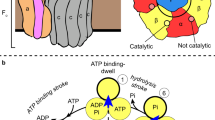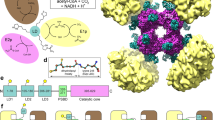Abstract
Fructose-1,6-bisphosphate (FBP) aldolase/phosphatase is a bifunctional, thermostable enzyme that catalyses two subsequent steps in gluconeogenesis in most archaea and in deeply branching bacterial lineages1,2,3. It mediates the aldol condensation of heat-labile dihydroxyacetone phosphate (DHAP) and glyceraldehyde-3-phosphate (GAP) to FBP4, as well as the subsequent, irreversible hydrolysis of the product to yield the stable fructose-6-phosphate (F6P) and inorganic phosphate; no reaction intermediates are released. Here we present a series of structural snapshots of the reaction that reveal a substantial remodelling of the active site through the movement of loop regions that create different catalytic functionalities at the same location. We have solved the three-dimensional structures of FBP aldolase/phosphatase from thermophilic Thermoproteus neutrophilus5,6 in a ligand-free state as well as in complex with the substrates DHAP and FBP and the product F6P to resolutions up to 1.3 Å. In conjunction with mutagenesis data, this pinpoints the residues required for the two reaction steps and shows that the sequential binding of additional Mg2+ cations reversibly facilitates the reaction. FBP aldolase/phosphatase is an ancestral gluconeogenic enzyme optimized for high ambient temperatures1,2, and our work resolves how consecutive structural rearrangements reorganize the catalytic centre of the protein to carry out two canonical reactions in a very non-canonical type of bifunctionality.
This is a preview of subscription content, access via your institution
Access options
Subscribe to this journal
Receive 51 print issues and online access
$199.00 per year
only $3.90 per issue
Buy this article
- Purchase on Springer Link
- Instant access to full article PDF
Prices may be subject to local taxes which are calculated during checkout




Similar content being viewed by others
Accession codes
Data deposits
Atomic coordinates and structure factors for the reported crystal structures are deposited in Protein Data Bank under accession numbers 3T2B (ligand-free), 3T2C (DHAP-bound), 3T2D (FBP-bound), 3T2E (F6P-bound), 3T2F (EDTA-soak with DHAP) and 3T2G (Y229F variant with DHAP).
References
Berg, I. A. et al. Autotrophic carbon fixation in archaea. Nature Rev. Microbiol. 8, 447–460 (2010)
Say, R. F. & Fuchs, G. Fructose 1,6-bisphosphate aldolase/phosphatase may be an ancestral gluconeogenic enzyme. Nature 464, 1077–1081 (2010)
Stetter, K. O. Hyperthermophiles in the history of life. Phil. Trans. R. Soc. B 361, 1837–1842 (2006)
Siebers, B. et al. Archaeal fructose-1,6-bisphosphate aldolases constitute a new family of archaeal type class I aldolase. J. Biol. Chem. 276, 28710–28718 (2001)
Messner, P., Pum, D., Sara, M., Stetter, K. O. & Sleytr, U. B. Ultrastructure of the cell envelope of the archaebacteria Thermoproteus tenax and Thermoproteus neutrophilus. J. Bacteriol. 166, 1046–1054 (1986)
Zillig, W. et al. The phylogenetic relations of DNA-dependent RNA polymerases of archaebacteria, eukaryotes, and eubacteria. Can. J. Microbiol. 35, 73–80 (1989)
Alefounder, P. R., Baldwin, S. A., Perham, R. N. & Short, N. J. Cloning, sequence analysis and over-expression of the gene for the class II fructose 1,6-bisphosphate aldolase of Escherichia coli. Biochem. J. 257, 529–534 (1989)
Fothergill-Gilmore, L. A. & Michels, P. A. Evolution of glycolysis. Prog. Biophys. Mol. Biol. 59, 105–235 (1993)
Rutter, W. J. Evolution of aldolase. Fed. Proc. 23, 1248–1257 (1964)
Lorentzen, E., Siebers, B., Hensel, R. & Pohl, E. Structure, function and evolution of the archaeal class I fructose-1,6-bisphosphate aldolase. Biochem. Soc. Trans. 32, 259–263 (2004)
Penhoet, E., Kochman, M., Valentine, R. & Rutter, W. J. The subunit structure of mammalian fructose diphosphate aldolase. Biochemistry 6, 2940–2949 (1967)
Tolan, D. R., Niclas, J., Bruce, B. D. & Lebo, R. V. Evolutionary implications of the human aldolase-A, -B, -C, and -pseudogene chromosome locations. Am. J. Hum. Genet. 41, 907–924 (1987)
Lebherz, H. G. & Rutter, W. J. Distribution of fructose diphosphate aldolase variants in biological systems. Biochemistry 8, 109–121 (1969)
Cooper, S. J. et al. The crystal structure of a class II fructose-1,6-bisphosphate aldolase shows a novel binuclear metal-binding active site embedded in a familiar fold. Structure 4, 1303–1315 (1996)
Lorentzen, E. et al. Crystal structure of an archaeal class I aldolase and the evolution of (βα)8 barrel proteins. J. Biol. Chem. 278, 47253–47260 (2003)
Hester, G. et al. The crystal structure of fructose-1,6-bisphosphate aldolase from Drosophila melanogaster at 2.5 Å resolution. FEBS Lett. 292, 237–242 (1991)
Gamblin, S. J. et al. The crystal structure of human muscle aldolase at 3.0 Å resolution. FEBS Lett. 262, 282–286 (1990)
Blom, N. S., Tetreault, S., Coulombe, R. & Sygusch, J. Novel active site in Escherichia coli fructose-1,6-bisphosphate aldolase. Nature Struct. Biol. 3, 856–862 (1996)
Imanaka, H., Fukui, T., Atomi, H. & Imanaka, T. Gene cloning and characterization of fructose-1,6-bisphosphate aldolase from the hyperthermophilic archaeon Thermococcus kodakaraensis KOD1. J. Biosci. Bioeng. 94, 237–243 (2002)
Andreeva, A. et al. Data growth and its impact on the SCOP database: new developments. Nucleic Acids Res. 36, 419–425 (2008)
Ronimus, R. S. & Morgan, H. W. Distribution and phylogenies of enzymes of the Embden-Meyerhof-Parnas pathway from archaea and hyperthermophilic bacteria support a gluconeogenic origin of metabolism. Archaea 1, 199–221 (2003)
Nishimasu, H., Fushinobu, S., Shoun, H. & Wakagi, T. The first crystal structure of the novel class of fructose-1,6-bisphosphatase present in thermophilic archaea. Structure 12, 949–959 (2004)
St.-Jean, M., Blonski, C. & Sygusch, J. Charge stabilization and entropy reduction of central lysine residues in fructose-bisphosphate aldolase. Biochemistry 48, 4528–4537 (2009)
Grazi, E., Rowley, P. T., Cheng, T., Tchola, O. & Horecker, B. L. The mechanism of action of aldolases. III. Schiff base formation with lysine. Biochem. Biophys. Res. Commun. 9, 38–43 (1962)
Rose, I. A. & Rieder, S. V. Studies on the mechanism on the aldolase reaction; isotope exchange reactions of muscle and yeast aldolase. J. Biol. Chem. 231, 315–329 (1958)
Lai, C. Y., Tchola, O., Cheng, T. & Horecker, B. L. The mechanism of action of aldolases. 8. The number of combining sites in fructose diphosphate aldolase. J. Biol. Chem. 240, 1347–1350 (1965)
St.-Jean, M., Lafrance-Vanasse, J., Liotard, B. & Sygusch, J. High resolution reaction intermediates of rabbit muscle fructose-1,6-bisphosphate aldolase: substrate cleavage and induced fit. J. Biol. Chem. 280, 27262–27270 (2005)
Ciszak, E. M., Korotchkina, L. G., Dominiak, P. M., Sidhu, S. & Patel, M. S. Structural basis for flip-flop action of thiamin pyrophosphate-dependent enzymes revealed by human pyruvate dehydrogenase. J. Biol. Chem. 278, 21240–21246 (2003)
Perham, R. N. Swinging arms and swinging domains in multifunctional enzymes: catalytic machines for multistep reactions. Annu. Rev. Biochem. 69, 961–1004 (2000)
Leslie, A. G. W. Recent changes to the MOSFLM package for processing film and image plate data. Joint CCP4 + ESF-EAMCB Newsletter on Protein Crystallography No. 26. (1992)
Evans, P. Scaling and assessment of data quality. Acta Crystallogr. D 62, 72–82 (2006)
Vagin, A. A. & Teplyakov, A. MOLREP: an automated program for molecular replacement. J. Appl. Cryst. 30, 1022–1025 (1997)
Murshudov, G. N., Vagin, A. A. & Dodson, E. J. Refinement of macromolecular structures by the maximum-likelihood method. Acta Crystallogr. D 53, 240–255 (1997)
Emsley, P., Lohkamp, B., Scott, W. G. & Cowtan, K. Features and development of Coot. Acta Crystallogr. D 66, 486–501 (2010)
Brünger, A. T. Assessment of phase accuracy by cross validation - the free R-value – methods and applications. Acta Crystallogr. D 49, 24–36 (1993)
Tabor, S. & Richardson, C. C. A bacteriophage T7 RNA polymerase/promoter system for controlled exclusive expression of specific genes. Proc. Natl Acad. Sci. USA 82, 1074–1078 (1985)
Studier, F. W. Protein production by auto-induction in high density shaking cultures. Protein Expr. Purif. 41, 207–234 (2005)
Acknowledgements
This work was supported by Deutsche Forschungsgemeinschaft (grant Ei520/3-2 to O.E., Fu118/15-4 and 15-5 to G.F.). Diffraction data were collected at beam lines X06SA and X06DA at the Swiss Light Source (Villigen, Switzerland). The authors thank the beam line staff for assistance during data collection.
Author information
Authors and Affiliations
Contributions
J.D. and W.L. crystallized the protein and collected diffraction data, J.D., W.L. and O.E. built and refined the structural models, R.F.S. created and analysed the variant proteins, J.D., R.F.S., W.L., G.F. and O.E. designed the experiments, O.E. wrote the manuscript.
Corresponding author
Ethics declarations
Competing interests
The authors declare no competing financial interests.
Supplementary information
Supplementary Information
The file contains Supplementary Figures 1-7 with legends, Supplementary Methods and Supplementary Tables 1-2. (PDF 1366 kb)
Rights and permissions
About this article
Cite this article
Du, J., Say, R., Lü, W. et al. Active-site remodelling in the bifunctional fructose-1,6-bisphosphate aldolase/phosphatase. Nature 478, 534–537 (2011). https://doi.org/10.1038/nature10458
Received:
Accepted:
Published:
Issue Date:
DOI: https://doi.org/10.1038/nature10458
This article is cited by
-
Catalytic site flexibility facilitates the substrate and catalytic promiscuity of Vibrio dual lipase/transferase
Nature Communications (2023)
-
An overview of sucrose transporter (SUT) genes family in rice
Molecular Biology Reports (2022)
-
Pcal_0111, a highly thermostable bifunctional fructose-1,6-bisphosphate aldolase/phosphatase from Pyrobaculum calidifontis
Extremophiles (2017)
-
Flux Control in Glycolysis Varies Across the Tree of Life
Journal of Molecular Evolution (2016)
-
Two enzymes with redundant fructose bisphosphatase activity sustain gluconeogenesis and virulence in Mycobacterium tuberculosis
Nature Communications (2015)
Comments
By submitting a comment you agree to abide by our Terms and Community Guidelines. If you find something abusive or that does not comply with our terms or guidelines please flag it as inappropriate.



